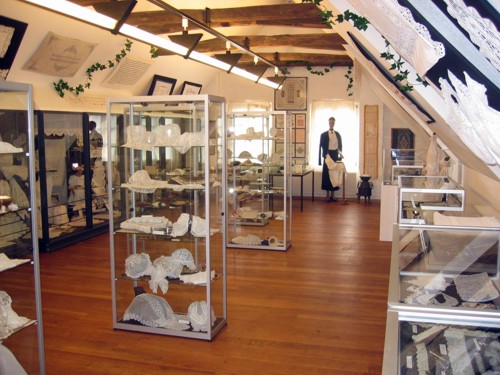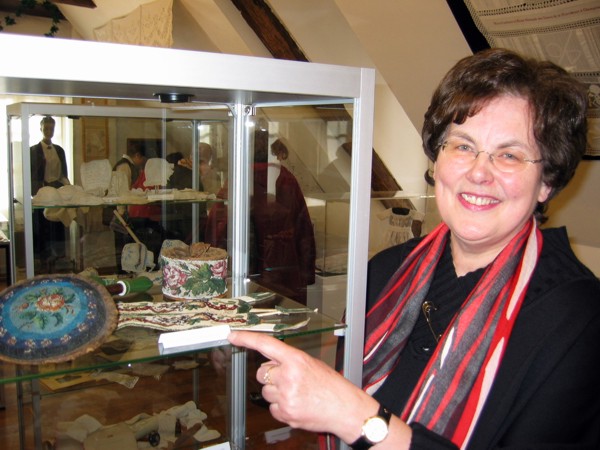Opening Times
The exhibition is open from 14.00 -18.00 on every first and third Sunday in
the month (apart from public holidays).
On every first Sunday in the month, the collector Monika Schmillenkamp gives
a professional explanation to all the exhibits, and anyone who is interested,
is invited to an open embroidery group. Group visits and guided tours out
of museum hours can be arranged with the office of the „Alte Brennerei“ on
the phone or it is possible directly with Monika Schmillenkamp under the number
02524/5398
The entrance costs 1 euro per person and children are free.
The exhibition

1. The museum shows about 500 exhibits of handmade textile
treasures.
The art of pillow lace out of finest thread is seen in a row of examples of
the 18th to 19th century from the centres Valenciennes, Mecheln and Binche,
Brüssels lace decorate collars, cuffs hankerchieves and Christening robes.
The different pillow lace tools from various lace regions are small works
of art.
2. The collection covers various examples of needle-point
lace of geometric Reticella, barock pattern (Point Plat de Venise), as well
as French and Belgian lace. Details of the techniques of filet lace, „Sonnenspitze“
and ribbon lace can be seen.
The beauty and delicacy of tulle embroidery and Dresden Lace (Point de Saxe)
is shown to full advantage on the bonnets and shawls.
3. The needle-work instruction of the late 19th century built
on the tradition of practising embroidery and other textile techniques on
cloth patterns The well-known red – embroidered ABC cloth came from that time.
The work of Fanny Lein from Wildenau done in 1890 is displayed next to these
exhibits. After completing the cross-stitch cloth pattern, she worked on a
patched and darned cloth of fine batiste.
Also included on the school timetable of that period was the sewing of cloth.
It shows the different stitches and hems as well as crochet pieces. This was
followed by the sewing on of buttons, hooks, loops and practice in button
holes.In addition to this work girls in priviliged schools and boarding schools
learnt elaborate, decorative sewing techniques. The museum shows many examples
from Belgium and Holland and two 4,80 metre long fabrics from boarding schools.
4. Further evidence of the needle-work instruction are the
knitting and crochet patterns in fine cotton thread. In the 19th century an
utensil or decorative object was hardly without pearl decoration. The exhibition
also consists of numerous exhibits from this time, mostly knitted beadwork,
tobacco pouches purses, pomadours, gloves, socks, baby bonnets accomplished
in elaborate and lovingly- done needle-work. The use of glass pearls followed
on in other techniques. It was crocheted, embroidered, threaded and pasted.
In the second half of the 19th century the delicacy of needle-work was gradually
lost. Pieces were partly accomplished in wool embroidery and pearls in between
for petals, ornaments and embellishments. Often perforated paper provided
the basis for this work. The museum shows several examples – notebooks, cigar
cases, packets,curtains for shelves and bellpulls.
The collector Monika Schmillenkamp

Monika Schmillenkamp born Bücker was born into a Westphalia textile
merchant family, and she grew up in a house influenced by the joy of beautiful
things, the familiarity of fine clothes and how to make them. From earliest
childhood she was introduced to different techniques of needle-work by her
aunt Frau Ruth Hunkemöller. She uses these skills today in the restoration
of old musuem needle-work pieces. For 25 years she has collected antique textiles,
historical embroidery patterns, literature and needle-work tools. She is greatly
supported in her work by her husband Wilfried Schmillenkamp.
Part of her extensive collection could be presented in 2002 and 2004 in an
impressive exhibition. Since March 2005 the rooms of the Ennigerloh Culture
Centre „Alte Brennerei“ have been at her disposal.